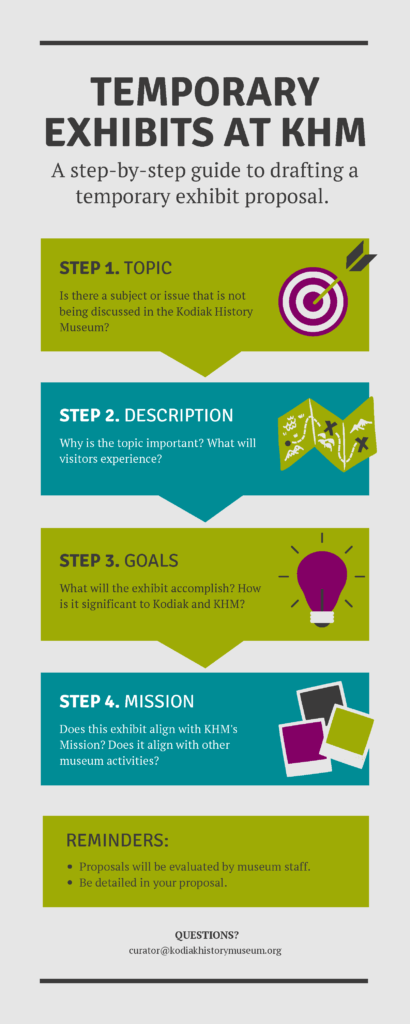In Spring 2022, the Kodiak History Museum debuted a new model for our temporary exhibit gallery. This blog post contains all you need to know about our new temporary exhibit program, how to be involved in the exhibit process, and any other facts!
The Program
KHM’s temporary exhibit program is social justice-oriented and community-based. In our new temporary exhibit program, KHM is working to replace the single authoritative voice in exhibits with that of many voices and perspectives in an effort to assert our relevance to the community of Kodiak and to find our place in contemporary Kodiak as a rebranded museum.
Our program is founded within the social justice in museums and decolonization movements. These movements recognize that museums have traditionally acted as gatekeepers of knowledge, parsing information out as warranted and to serve political needs. As a result, the museum culture in the US was based on the norms of dominant society and institutionally marginalized those not part of the dominant society. However, museums can become sites for social inclusion by working to address social issues with community partners. Efforts toward inclusivity allow museums to be more socially conscious institutions, especially in exhibit interpretation.
Our work with this program is also centered within the Museums Are Not Neutral movement. Museums have long been considered to be repositories – places where objects are held. However, museums are not just repositories; they are places when objects are interpreted through exhibits and educational programs. In other words, they are not apolitical or neutral; there is always some interpretation or bias of opinion. Museums today are currently undergoing a rapid change in interpretation; they are moving from offering a temple of knowledge for the already educated to a forum for the public where learning is active and dynamic.
Our new model creates two temporary exhibits per year with key partners. Key partners propose the exhibit topic, and they take the lead in organizing the exhibit with the help of KHM staff, making them co-created exhibits. In co-created exhibits, community members are part of the key decision-making in organizing and creating an exhibit; community voice is a key aspect of the narrative and is present throughout the whole exhibit. Co-creative projects begin with community needs in mind as well as those of the museum. Projects like KHM’s new temporary exhibit program accomplish three primary goals:
- Give voice and be responsive to the needs and interests of local community members
- Provide a place for community engagement and dialogue
- Help participants develop skills that will support their own individual and community goals



A look at KHM’s Hunt, Fish, Gather, Grow: Exploring Food Security in Kodiak (2020-2022). This exhibit was KHM’s first effort using a co-creative exhibit model.
The Purpose of the Model
KHM recognizes that current events and issues are history in the making. We also recognize the idea that past events and historical legacies directly impact our Kodiak community, and critical engagement with the past fosters awareness of the origins of today’s events. To critically engage with the past requires investigation into past historical and institutional biases – what was collected, why it was collected, why we talk about these events, and what is missing from these collections and histories. History is not simple and straightforward; history was experienced differently by different populations. This investigation, through the form of community-based temporary exhibits, promotes an inclusive Kodiak history.
How To Be Involved
KHM’s temporary exhibit program utilizes an open call model for proposals. The link to the proposal form is here. Proposals are reviewed on a quarterly basis, and they are evaluated on topic, significance, and relevance to KHM’s mission.
Once a topic has been selected, KHM will work together with the proposer and/or a key partner (if not the same person) to create the exhibit. There will be a minimum of four meetings to develop each exhibit.
A Note About Proposals
KHM is looking to create exhibits with underrepresented communities in Kodiak. If you are submitting a proposal about one of these communities and not a member of that community, we ask that you partner with a community member or organization to create the proposal.
Additionally, proposals that contain more information are more successful in the proposal process. Proposals should communicate a clear idea and a beginning concept for the exhibit.
If your proposal is not initially successful, we ask that you revise and resubmit the proposal in the future.

